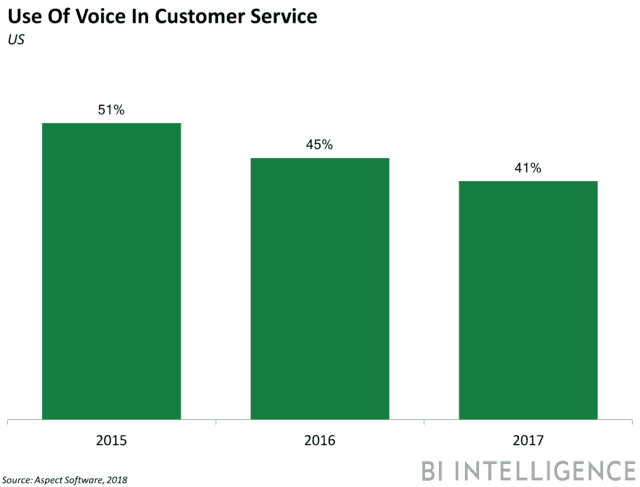Customer service adds to the value of your product since 66% of consumers are willing to spend more with companies that offer excellent customer service. And this is vital because a 5% increase in customer retention can produce 25% more profit. However, most eCommerce companies can’t afford a room full of customer service representatives standing by to answer consumer questions. Customer service software allows you to provide the information shoppers want quickly and without spending a lot of money.
Automation drives the revolution in customer service software
These days, automation is the key to good customer service for shoppers as well as eCommerce businesses. A Zendesk survey found that 67% of customers prefer to find answers to their questions on their own rather than speaking to a customer service rep. And 40% of the people who made a customer service call had tried to find an answer online before calling.
This continues a trend from the last few years. In 2018, Business Insider Intelligence reported that 49% of customers prefer to get help through automated channels. That number is even higher for millennials (66%). Automation is one of the most important eCommerce customer service trends. (And, of course, excellent eCommerce fulfillment is a terrific way to improve your customer experience.)

Here are some of the best B2C customer service software solutions for eCommerce.
What can customer service software do for you?
Before choosing one or more customer service software solutions, it’s essential to understand which features are most important to your business and your customers. You can use this list of benefits as your checklist when you’re seeking customer service automation.
Increased accountability
Every contact is documented in a customer service app. This allows management to monitor each agent’s performance.
Improved coordination
Integration with sales systems is critical, allowing for better coordination between the sales and customer service departments.
Better integration
The software should integrate with service dispatch as well as asset management. Your agents should be able to track inventory items at all times.
Improved infrastructure
Simple queries can be dealt with via customer self-help systems. More complex problems can be routed directly as tickets to agents.
Reduced times to resolve issues
Customer service software solves problems faster, leading to higher rates of customer satisfaction. In addition, it increases the number of queries your business can resolve.
Multi-channel service
Customers want to interact using a variety of channels. Customer service software can support queries through email, social media, live chat, helpdesk, and phone. Providing answers seamlessly across multiple channels is essential.
24/7 customer support
Part of the appeal of online shopping is that the store is open all the time. Customers don’t want to wait until business hours to get help with their purchases.
Take back your time
Automation through customer service software relieves you of mind-numbing tasks. Use technology to sort tickets, route queries, manage queries, and create reports for you.
Data analysis
The data that your customer service app collects can help you understand trends in your business. Combined with data from your 3PL, this can help you gain insights into everything from which products seem defective to forecasting demand. An analysis of the data can show you problem areas and point the way toward solutions.
Gather kudos from customers
Good customer service can turn a problem into a happy interaction, and your customer service app should give customers a chance to share that. Use your customer service software to create testimonials from positive feedback. And negative feedback is also invaluable for improving your product, your processes, and your customer experience.
A “Wow!” experience
These benefits aren’t valuable unless you offer your customer a great experience. Your customer service should wow them every single time.

Where to start: helpdesk software
Helpdesk software allows you to manage all your customer service activities. Helpdesks use a support ticket system to track customer interactions across many channels. That allows you to track email, social media, live chat, and phone calls on a single dashboard.
Helpdesk customer service software has three main components:
- Ticket management. Customer support queries are gathered and assigned tickets, which can be managed centrally. This also allows each ticket to be tracked and monitored in real-time.
- Automation suite. Helpdesk coordinators can automatically direct questions. Automation matches customer queries with the agents best able to answer them. The software sends the coordinator notifications. If an agent doesn’t respond to a ticket or takes too long to resolve, a manager can intervene.
- Reporting and Optimization. Gather and record data about critical aspects of your customer service operations. Get reports about workload, turnaround time, and resolution time can be. These metrics give a quick perspective to managers and can be analyzed to optimize future performance.

Once you have your helpdesk software in place, it’s time to consider which additional support apps will help you provide the excellent customer service that online shoppers demand.
5 types of customer service software
To cover all your bases, you’ll need your customer service software to do many different things and to reach customers wherever they are. Not only that, your software should be able to help you identify when the same customer messages you on more than one customer service channel. Here are four main categories to consider:
Email support software
Offering email support to your customers is a must. You can allow customers to contact you either via a contact form on your website or a public email address.
Email poses multiple challenges for your agents:
- They have to deal with a potentially large volume of requests per day.
- Agents must respond to each customer’s questions quickly.
- They must not forget to reply to an individual customer’s query.
- Managing multiple threaded conversations can be tricky.
It’s a good idea to have a separate email account for support requests.
Email support software can help you with:
- Managing different brands, products, or departments from a single account.
- Reports that help you track key support metrics. Plus, reports on agent performance and customer satisfaction.
- Tagging queries.
- Triggering automation.
You know you’re getting it right if you can personalize every customer interaction.
Live chat software
Live chat is the preferred method for customer service interaction for the vast majority of online consumers. It allows you to respond to your customers quickly with answers tailored to their specific issues. They don’t have to make a phone call, and the ability of agents to conduct multiple chats simultaneously reduces wait times.
Live chat software can allow you to implement:
- Reactive handling of pre-sales inquiries
- Proactive selling to hesitant buyers
- Post-sales support
To make the most of live chat, take time to study your chat transcripts. Are there issues raised through customer feedback that you could address at a high level?
Chatbots
Live chat is terrific, but it requires agents. Chatbots can provide answers to your most common questions and refer a customer to live chat if their problem is more complex. Chatbots with AI tools such as natural language processing can parse customer inquiries and provide information faster than a live agent. And, with the proliferation of chatbot apps, even small eCommerce companies can afford to use chatbots.

Here are some of the features to look for in chatbot software:
- Multi-platform operability will allow you to offer chat on your social platforms, as well as your website.
- Integration with your live chat software for seamless transitions when needed.
- Your chatbot must work on mobile as more eCommerce sales and inquiries transition to mobile devices.
- Look for chatbot builder that includes lead capture and remarketing tools.
Social media management software
It’s critical to give customers positive social customer care experiences. When you do, they are nearly three times more likely to recommend your brand, according to a study by NM Incite.
Customers expect brands to offer customer service on social media. They don’t care if you only use your Twitter for PR, and they will often post on multiple social media channels to try to resolve their issue. Consumers who send queries on social media expect a response within the hour, and you need to be prepared to provide it.
The problem in many eCommerce businesses is that different people run each channel. These people often have different agendas and priorities, so customers skipping across channels could have different experiences. This can confuse consumers and hurt your brand image.
Social media management software can provide the following:
- Integration of all your social channels.
- Faster response times through greater efficiency.
- Consistency of service across channels.
- Enhanced social listening.
The key is to be responsive and active on all your accounts and respond to and resolve complaints quickly.
Inbound phone support software
While chat and social are vital, customer service via telephone is still a popular option, particularly for older consumers. Providing quality phone support can be expensive. However, it offers important advantages:
- Clear communication. You will learn more from your customer during a phone conversation than via email.
- Building rapport. Talking directly with a prospect can build rapport and turn a first-time shopper into a long-term buyer.
- Building trust. Customers may want to talk to you before they buy, especially when considering a high-dollar purchase. They want to know they can trust you first.

Inbound phone support software can help you in the following ways:
- Automatic Call Distribution (ACD). ACD allows you to create rules for distributing incoming calls. The rules could relate to the time of day, custom percentages, or agent skills.
- Interactive Voice Response (IVR). Pre-recorded messages can provide self-service information, which works well for queries that don’t need an agent.
- Live Call Monitoring. Managers can listen to calls in real-time and give advice to an agent mid-call. Managers can also “call barge” or take over a call that needs special attention.
What to consider when choosing a customer service software package
Here are the boxes to check as you look for excellent customer service software.
Software type
What channels do your customers prefer for connecting to you? Consider a survey to gather data, and look at existing customer service interactions to understand how your customers want to reach you.
Ease of use
Customer service software that isn’t intuitive to use is of no service. If possible, start with a free trial; that way, you can experience the setup and interface before committing.
Integration of customer service software with crucial business processes such as sales and marketing
You probably use more than one piece of customer support software, and all your apps should work well together. Customer service apps that integrate smoothly with your CRM and other software will add value in the long run.
Remote access
When you run an eCommerce business, you aren’t tied to an office. Your customer service apps should provide easy remote access that you can use on any mobile device so you can respond on the go.
Mobile and voice assistant access
Your users need to be able to contact you through mobile and voice assistants such as Alexa. Make sure your customer service software works well for mobile and voice users.
Reliable tech support
When your customer support software crashes, your customer support operation crashes too. Choose a software platform that has a rapid response to help you troubleshoot any problems that arise.
Ability to scale up
Switching customer service software platforms takes time that you can’t afford to lose once you’re growing. Choose a platform that serves businesses from small to large. You want customer service apps that will continue to serve you as your business scales.

8 excellent customer service software solutions for eCommerce businesses
Customer service software can improve your business operations. At the same time, it can make your customers happier. There aren’t many things in life that are such a win-win.
There are many useful customer service software solutions on the market. Choose one that has the features your business needs at a price that you can afford. You might end up using more than one customer support software app. It often takes multiple apps to meet all your customer service automation needs. Many of these apps integrate with one another.
In addition, choose a well-established software company. The newest customer service software solution may come with bells and whistles. However, if that startup folds, you may have to scramble. If this happens without notice, you could end up with a customer service crisis.
Here are eight options for excellent customer service software:
1. Zendesk
The helpdesk software company Zendesk was founded in 2007, making it a wise elder among customer service software apps. It has 100,000 paid customers, both large and small businesses. Zendesk obviously has a solid business model and staying power in a volatile sector.
Pros: Zendesk is easy to set up and has many useful features. The company serves businesses of all sizes. Therefore, you can stay with Zendesk from startup to global conglomerate. Zendesk offers support in multiple languages, which is crucial if you want to reach global eCommerce markets. The company also offers good tech support.
Cons: Great customer service comes with a price tag to match. Zendesk can be expensive, especially if you need to add more features.
2. LiveAgent
LiveAgent is a popular helpdesk customer service software app. It provides multichannel support. LiveChat integrates social media customer service with email and phone. You can start with a two-week free trial to see how you like the interface.
Pros: LiveAgent is quick to set up and easy to learn. Users of the app get robust customer support. You aren’t locked into a contract. You can purchase more or less support from LiveAgent. It is easy to change your plan as your business needs fluctuate. There are a host of features you can customize. In addition, LiveAgent is priced to fit your startup budget.
Cons: LiveAgent is still working out the kinks in its mobile app. It also might not integrate with the other business software systems you use. Be sure to check this before you choose LiveAgent.
“Our target niche/niche which can get the most value of the software is eCommerce SMB. ([That is] online stores, SaaS vendors, Phone companies). We think of customer service as our competitive advantage – this is what we do best.”
— David Cacik, Head of Marketing at LiveAgent
3. Kayako
Another well-regarded helpdesk software solution is Kayako. This helpdesk supports email, phone, and live chat customer support. It has been around even longer than Zendesk. Therefore, Kayako has had plenty of time to work out the kinks in its software.
Pros: You can access your dashboard from a cloud host or host yourself, so you can respond to customer messages wherever you are. There is a knowledge base tool that can answer many customer questions, which can save you valuable staff time. You can scale up as your business grows. And the pricing is affordable, with plans that start as low as $24.
Cons: To access Kayako’s most outstanding features, you’ll have to buy the most expensive plan. The interface isn’t the smoothest. In addition, customers have reported trouble receiving email queries.
“Kayako focuses on technology-enabled retailers. Where we really shine is providing digital-first retailers a support software that allows them to put great service and customer experience at their core.”
— Adam Rogers, Content Marketing Manager at Kayako
4. Talkdesk
Phone calls are very old-school. You won’t catch a millennial talking on a smartphone. However, your customers may want to speak with a customer service agent. Talkdesk is a good solution, offering VOIP customer service software.
You can’t rely on the phone as your only customer support channel. Therefore, consider integrating Talkdesk with Zendesk or Salesforce. Consider it part of your CRM package.
Pros: Talkdesk creates a call log. The app makes it easy for you to find the customer call you’re looking for. You can have several lines feed into your Talkdesk account. This customer service software gets high marks for reliability. It is also easy to use.
Cons: Users report that the software can glitch, forcing you to restart. The call transcriptions are imperfect (as anyone who uses Siri or Hey Google has experienced). However, users did appreciate this feature. There have also been some complaints about Talkdesk’s customer support.
5. Pure Chat
Pure Chat not only provides live chat customer service: it also tracks your site visitors. The tracking collects helpful information about the shoppers who visit your website. You don’t have to wait for visitors to ask a question – you can reach out to them. Pure Chat offers a free trial and a free base plan.
Pros: Pure Chat saves transcripts of your customer communications. The software creates a log so you can track your chat metrics. There are lots of customizable features. In addition, you can manage multiple chats in real-time.
Cons: The pro plan is $99 per month, which can get pricey if it’s one of several customer service software solutions you use. In addition, Pure Chat only supports English. Therefore, this isn’t a good solution if your business is global.
“Pure Chat has more than 100,000 small business customers who love how simple our live chat software is to use. We made our tool with small businesses in mind and created mobile apps right off the bat. So, business owners who are on the go and strapped for time can offer amazing customer service from anywhere.”
— Arielle Hurst, Marketing Lead at Pure Chat
6. Sprout Social
Sprout Social is a social media customer service software platform that supports interactions between brands and their customers. This platform provides more than customer service software, and you might want to take advantage of the other Sprout Social features. But don’t discount it as a tool for social media customer support. You can check out Sprout Social with a free trial.
Pros: Sprout Social works well on mobile devices. It has a CRM built right in. It provides a wealth of tools and flexible features. The dashboard is easy to use, and you can create reports from the app.
Cons: You’ll have to buy the premium plan to access customer service support. It can get pricey if you need licenses for several customer service team members. And it excludes some popular social platforms, most notably YouTube.
“Forget phone, email, and live chat. Facebook, Twitter, and other networks are the new front lines for customer service questions.”
— Andrew Caravella, Vice President of Marketing at Sprout Social
7. Olark
Olark is a live chat customer support software. It has been around almost as long as live chat (since 2009). Fun fact: you can dress your chat icons up for different holidays. That is a plus if your eCommerce business is seasonal. You can highlight Christmas as well as other holidays.
Pros: Olark gets high marks for easy setup and use. You can design your chat icon. Use Olark’s templates or pay extra for custom edits. It provides a feedback form that can automate the collection of customer insights. Olark has a free plan and one paid plan, which isn’t expensive.
Cons: It doesn’t include a system for creating tickets. You’ll have to integrate with Zendesk or another CRM solution. Therefore, Olark doesn’t work as well as a standalone.
“Every eCommerce business should offer live chat. Consumers just expect it now. And if you’re not offering live chat, there’s a pretty strong chance you’re losing out on sales and new customers, increasing the likelihood of churn. We believe live chat should be immediate (synchronous) and human. When a customer has a question, they shouldn’t have to wait in a queue to get an answer. And they should expect to talk to a real human.”
— Karl Pawlewicz, Voice of Olark
8. Help Scout
Help Scout is email customer service software. It also supports live chat. The app helps you manage internal and external email interactions. In addition, it can streamline communications within large internal teams.
Pros: Help Scout brings the power of automation to your customer service emails. It can tag emails to go to the correct department and create reports. Users love the Help Scout dashboard and customer support. It includes a traffic feature to prevent multiple team members from sending responses to the same query.
Cons: Help Scout doesn’t have a wide array of features. Its features fall short of some other customer service apps. In addition, the subscription costs can add up if you have a lot of users.
“Absolutely, you should talk to your customers through social channels and chat. But there’s no better place to tie all of those conversations together than email. It’s the most accessible, most flexible, and well-understood medium. By integrating your other channels into something like Help Scout, you can start to really build great long-term relationships one-to-one.”
— Tim Thyne, Head of Sales and Success at Help Scout
Additional customer service software platforms to consider
Hubspot has a helpdesk/ticketing capacity. It is a no-brainer to take advantage of Hubspot’s customer service features for businesses already using their CRM.
Gorgias lets you manage all your customer service channels in one place and automate many customer service tasks. And it’s an excellent choice for online businesses because it integrates with Shopify, Magento, and BigCommerce, three of the most popular eCommerce platforms.
For startups and small online businesses, Groove offers low-cost software with automation tools that let you do more with less. Plus, the collaboration features will help your customer support team do more with less.

What customer service software is right for your business?
The customer service software tools covered here are just some of the many applications available to eCommerce businesses. Each one can enhance the efficiency and results of your customer service.
Whatever software you choose, remember that customers are looking for an experience that’s personalized and meaningful. By adding automation and machine learning tools to your customer service team, your customer service software allows you to offer the fast, efficient, and helpful service that online shoppers expect.
And don’t forget the order fulfillment experience as part of your customer satisfaction plan. At Red Stag Fulfillment, we have found that accurate, fast fulfillment is the best way to make our clients’ customers happy. Give us a call to see how we can help you delight your customers.
More about customer service:
- Maximize the Value of Repeat Customers
- Make Lifelong Customers from Impulse, Seasonal Buyers
- How Smart Fulfillment Partners Support ECommerce Growth







